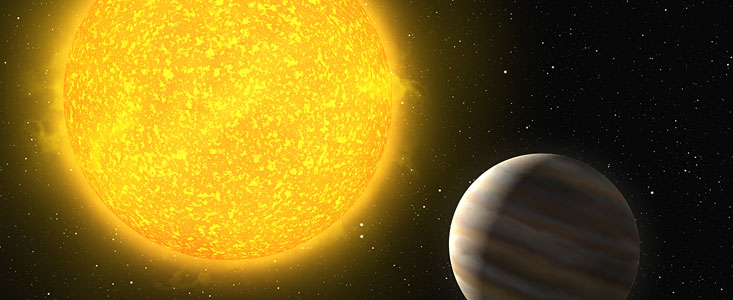Pressmeddelande
Students Discover Unique Planet
4 december 2008
Three undergraduate students, from Leiden University in the Netherlands, have discovered an extrasolar planet. The extraordinary find, which turned up during their research project, is about five times as massive as Jupiter. This is also the first planet discovered orbiting a fast-rotating hot star.
The students were testing a method of investigating the light fluctuations of thousands of stars in the OGLE database in an automated way. The brightness of one of the stars was found to decrease for two hours every 2.5 days by about one percent. Follow-up observations, taken with ESO's Very Large Telescope in Chile, confirmed that this phenomenon is caused by a planet passing in front of the star, blocking part of the starlight at regular intervals.
According to Ignas Snellen, supervisor of the research project, the discovery was a complete surprise. "The project was actually meant to teach the students how to develop search algorithms. But they did so well that there was time to test their algorithm on a so far unexplored database. At some point they came into my office and showed me this light curve. I was completely taken aback!"
The students, Meta de Hoon, Remco van der Burg, and Francis Vuijsje, are very enthusiastic. "It is exciting not just to find a planet, but to find one as unusual as this one; it turns out to be the first planet discovered around a fast rotating star, and it's also the hottest star found with a planet," says Meta. "The computer needed more than a thousand hours to do all the calculations," continues Remco.
The planet is given the prosaic name OGLE2-TR-L9b. "But amongst ourselves we call it ReMeFra-1, after Remco, Meta, and myself," says Francis.
The planet was discovered by looking at the brightness variations of about 15 700 stars, which had been observed by the OGLE survey once or twice per night for about four years between 1997 and 2000. Because the data had been made public, they were a good test case for the students' algorithm, who showed that for one of stars observed, OGLE-TR-L9, the variations could be due to a transit — the passage of a planet in front of its star. The team then used the GROND instrument on the 2.2 m telescope at ESO's La Silla Observatory to follow up the observations and find out more about the star and the planet.
"But to make sure it was a planet and not a brown dwarf or a small star that was causing the brightness variations, we needed to resort to spectroscopy, and for this, we were glad we could use ESO's Very Large Telescope," says Snellen.
The planet, which is about five times as massive as Jupiter, circles its host star in about 2.5 days. It lies at only three percent of the Earth-Sun distance from its star, making it very hot and much larger than normal planets.
The spectroscopy also showed that the star is pretty hot — almost 7000 degrees, or 1200 degrees hotter than the Sun. It is the hottest star with a planet ever discovered, and it is rotating very fast. The radial velocity method — that was used to discover most extrasolar planets known — is less efficient on stars with these characteristics. "This makes this discovery even more interesting," concludes Snellen.
Mer information
Snellen I. et al. 2008, OGLE2-TR-L9b: An exoplanet transiting a fast-rotating F3 star, Astronomy and Astrophysics, in press.
The team is composed of I.A.G. Snellen, M.D.J. de Hoon, R.F.J. van der Burg, F.N. Vuijsje (Leiden Observatory, The Netherlands), J. Koppenhoefer (Observatory of Munich, Germany), S. Dreizler (Georg-August University Göttingen, Germany), J. Greiner, T. Krühler, R.P. Saglia (Max-Planck Institute for Extraterrestrial Physics, Garching, Germany), and T.O. Husser (South African Astronomical Observatory).
Kontakter
Ignas Snellen
Leiden Observatory
Leiden, Netherlands
Tel: +31 71 52 75 838
Mobil: +31 63 00 31 983
E-post: snellen@strw.leidenuniv.nl
Meta de Hoon
Leiden Observatory
Leiden, Netherlands
Tel: +31 65 24 36 179
E-post: meta.dehoon@gmail.com
Remco van der Burg
Leiden Observatory
Leiden, Netherlands
E-post: vdbur@strw.leidenuniv.nl
Francis Vuijsje
Leiden Observatory
Leiden, Netherlands
E-post: vuijsje@strw.leidenuniv.nl
Henri Boffin
ESO
Garching, Germany
Tel: +49 89 3200 6222
E-post: hboffin@eso.org
Valentina Rodriguez
ESO
Garching, Germany
Tel: +56 2 463 3123
E-post: vrodrigu@eso.org
Om pressmeddelandet
| Pressmeddelande nr: | eso0845 |
| Legacy ID: | PR 45/08 |
| Namn: | OGLE-TR-L9, OGLE-TR-L9b |
| Typ: | Milky Way : Star : Circumstellar Material : Planetary System |
| Facility: | MPG/ESO 2.2-metre telescope, Very Large Telescope |
| Instruments: | FLAMES, GROND, UVES |
| Science data: | 2009A&A...497..545S |


